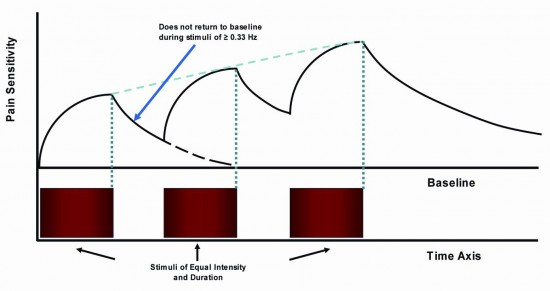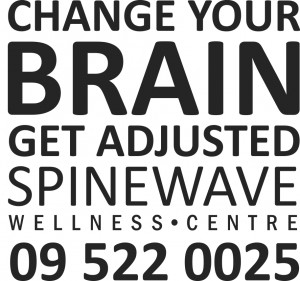“This is a fascinating insight. For those experiencing chronic pain and for those who have acute pain from recent injury… this is a must-read! It makes me wish I had received the right sort of chiropractic care 4 years ago before my pain became chronic. I’m glad I’m onto it now though – just a slightly longer journey to recovery. Thanks Neil for your patience and care – glad you haven’t yet sent me to have my anterior cingulate cortex removed – ha! It’s great to have such positive treatment, thanks again!”
Kate Caughey
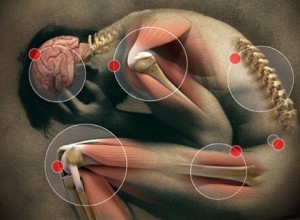 If there was a common denominator in most practices, and the human experience as a whole, it would be pain. And barring clients seeking care at Spinewave for nervous system disorders, people invariably show up because pain has alerted them to a problem.
If there was a common denominator in most practices, and the human experience as a whole, it would be pain. And barring clients seeking care at Spinewave for nervous system disorders, people invariably show up because pain has alerted them to a problem.
The challenge is deducing when pain has morphed into something else – something bigger, uglier – where it’s coming from and how to deal with it appropriately. When does pain move from acute to chronic? How does it change over time from just one place, to “now I hurt everywhere, all the time”? Constant headaches, aching spinal pain, relentless shoulder tension, leg or arm pain: When these or more start becoming the “normal” response of the body it’s time to consider some of the tricky concepts in pain.
This article will highlight three concepts foreign to most people in an attempt to expand one’s understanding of why healing can take time when it comes to pain:
- The pain wave.
- Central sensitisation.
- Emotional overlay.
I went cave diving once in the Western Cape. It wasn’t very deep but I had problems with my ears and was nervous. I asked the doctor on site how deep I should go. He said, son, the body has a wonderful warning system which tells you that you’re too deep: it’s called pain.
Due to its aversiveness, pain grabs attention, interrupts ongoing behaviour, and urges actions aimed at mitigating painful experience. Pain responses can be simple reflex arcs just to the spinal cord and back, e.g. touching the hot stove and withdrawing. Or they can be deeper relays into the spinal cord and up to the brain where the sensation of pain is actually perceived. If this persists, over time different phenomena start to occur.
The pain wave
Chronic pain can be its own disease. Because neuroplastic adaptations (memory) to an initial episode of pain occur in the nervous system, chronic pain turns out to have a distinct pathology unto itself. It causes changes in the nervous system that often worsen over time and has significant psychological and cognitive effects as well. People perceive pain differently since everyone’s brains are wired differently. I take the [very common] saying “I have a high pain threshold” with a pinch of salt because the long lasting effects on the nervous system can be deleterious in the absence of one’s conscious awareness. Sometimes the brain doesn’t care how you feel – or don’t feel – about things.
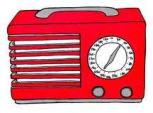 Pain is like your least favourite radio station. The intensity is the loudness of the volume, and the unpleasantness of the pain is the extent to which that volume is perceived annoying. So if it’s really loud, and really annoying, you’ve got a serious problem. Then your least favourite song, say something by James Blunt, mysteriously lands on repeat and that signal is sent over and over into the spinal cord and brain.
Pain is like your least favourite radio station. The intensity is the loudness of the volume, and the unpleasantness of the pain is the extent to which that volume is perceived annoying. So if it’s really loud, and really annoying, you’ve got a serious problem. Then your least favourite song, say something by James Blunt, mysteriously lands on repeat and that signal is sent over and over into the spinal cord and brain.
The original problem might have been a low back injury or a wrist injury, but now the signals have been transferred to the spinal cord because of the progressive repetition. This important mechanism of pain amplification is called “windup”.
Windup begins to shift the pain from acute to chronic. The quality of the pain changes to dull, aching or burning whereas before it might have been sharp or lancinating. The importance of windup is that it creates what I call the “pain wave”. It’s an upward crashing wave which gets stronger with every repeated stimulus of pain, like a tsunami gathering more force with the more water it collects as it moves toward the shoreline and there is less depth in the ocean floor. Suddenly it crashes onto land taking out every other brain neuron in its path.
This graph represents equal pain stimuli applied over time. With chronic pain, the important thing to notice is that pain sensations do not return to normal, or baseline, when the stimulus is removed. Pain sensitivities accrue like credit card debt on minimum wage. This leads the nervous system into allodynia.
Central sensitisation
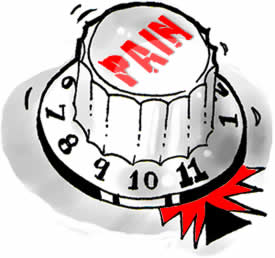 Allodynia means a stimulus that never used to cause pain before, now does. When pain sensitivity has reached a certain point, very little input from pain receptors is required to maintain this sensitised state. Thus, seemingly innocuous daily activities might contribute to the maintenance of the chronic pain state. The mind begins to misperceive the body and people become confused as to what is causing what, where the pain is actually coming from exactly, or begin treating it inappropriately with the wrong modalities.
Allodynia means a stimulus that never used to cause pain before, now does. When pain sensitivity has reached a certain point, very little input from pain receptors is required to maintain this sensitised state. Thus, seemingly innocuous daily activities might contribute to the maintenance of the chronic pain state. The mind begins to misperceive the body and people become confused as to what is causing what, where the pain is actually coming from exactly, or begin treating it inappropriately with the wrong modalities.
Central sensitisation means the neural programming of the pain has now moved from the problem site, or somewhere on the periphery, to the “centre” – the spinal cord and brain. The radio signals spoken of before coming into the spinal cord set off an inflammatory response, which is a powerful alarm signal for the body. It generates a cascade of reactions and produces chemical reactions en masse. Its persistence tells the brain to upregulate its sensitivity in the phenomenon of windup and create a pain wave. The tricky thing about this concept is that the perception of pain now becomes embedded in the system even once the original injury has healed.
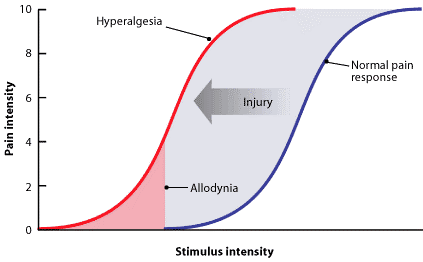
At this point the autonomic nervous system becomes involved – the fight/flight system. Why is it relevant? The role of the autonomic nervous system is to enable us to adapt to stress. But now that the spinal cord has become compromised through central sensitisation, it becomes “hyperexcitable” and stress will set off the same pain in the body. The underlying mechanism of central sensitisation is hyperexcitable neurons in the spinal cord that transmit pain input to the brain. This is detrimental. Over time continued bombardment of these signals into the brain will begin to change the way the brain is mapped, and the way the brain perceives the body, and the way it perceives pain. It becomes longer lasting.
 A simple example of this mechanism would be phantom limb pain. The arm or leg is no longer present, but the individual still perceives an itch or pain in the area where the limb used to be. Why? Because the area in the brain that maps the arm or leg is still firing. This is why early, appropriate treatment is important for people with pain before it becomes chronic. Not simply thinking, oh, it feels fine today, it’ll be okay, it comes and goes.
A simple example of this mechanism would be phantom limb pain. The arm or leg is no longer present, but the individual still perceives an itch or pain in the area where the limb used to be. Why? Because the area in the brain that maps the arm or leg is still firing. This is why early, appropriate treatment is important for people with pain before it becomes chronic. Not simply thinking, oh, it feels fine today, it’ll be okay, it comes and goes.
Chiropractic plays a crucial role in identifying these problems because good assessments of the autonomic nervous system can determine how far up the pain tree any particular problem has climbed already in the nervous system. This is done through neurological exam (pupil responses, cold or clammy palms, temperature fluctuations, runny nose, gut troubles, palpitations, blood pressure, pain responses) and by technological assessment (thermography, heart rate variability). Appropriate adjustments are then done over time to start correcting the system.
Emotional overlay
Lastly in the tricky concepts of pain is emotional overlay. When human beings make a decision, they will count, tally, analyse, draw up pros and cons, but the deciding factor will always rest on how one feels about the situation. So believe it or not, there will always be emotional overlay to pain and problems which will shape the nature of pain because the neural pathways of physical pain and emotional pain are shared.
“Pain overlap theory” proposes that social pain, the pain we experience when social relationships are damaged or lost, and physical pain, the pain that we experience upon physical injury, share parts of the same underlying processing system. This system is responsible for detecting pending danger and bracing the individual for impact. Fear and anxiety are core mechanisms of bracing which alters body chemistry, the spine, and ultimately the brain. Tying this back into central sensitisation and understanding how important the spinal cord, autonomic nervous system and brain is to processing pain, it starts to become clear how feeling can moderate the experience of pain, making it better or worse. A true case of mind – and emotion – over matter.
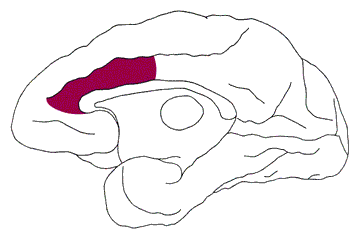
Once the pain mechanisms from the original injury, or series of injuries, have taken root in the nervous system, the “anterior cingulate cortex” will light up. This is a large structure in the brain which is part of the emotional cortex and is a key neural structure involved in the distress of the physical-social pain overlap. In the mid-1930s, neurosurgeons used to cut this bit out for the treatment of intractable chronic pain disorders. This part of the brain is almost distinct to humans and is critical why, when we’re upset, we experience physical pain. Or why when we’re on the go all the time, never resting, stressed out, the body will begin to manifest pain syndromes. Treatment of the “affected” area will be in vain. Resolution generally requires a multi-modal, holistic approach to returning to full health: Body, mind and spirit.
© Dr Neil Bossenger 2011

